In the rare and colorful world of pearls, mother of pearl stands out with its mysterious beauty and shimmering glow. The question what is mother of pearl? opens up a journey of discovery into the natural origins and formation process of this material from the innermost layer of a shell. Meanwhile, what is the value of mother of pearl? refers not only to its material worth but also to its symbolic value, representing purity and natural beauty. Mother of pearl is not only cherished in the jewelry industry but also in art and interior design, adding a touch of luxury and elegance to every creation.
Contents [hide]
1. What is Mother of Pearl?
1.1 Properties and Characteristics
Mother of pearl, scientifically known as nacre, is the lustrous material that forms the inner layer of certain mollusk shells, such as oysters, mussels, and abalones. It is highly valued for its iridescent glow, which reflects light in a rainbow of colors. Often used in jewelry, decorative items, and even musical instruments, mother of pearl has become a symbol of elegance and craftsmanship.
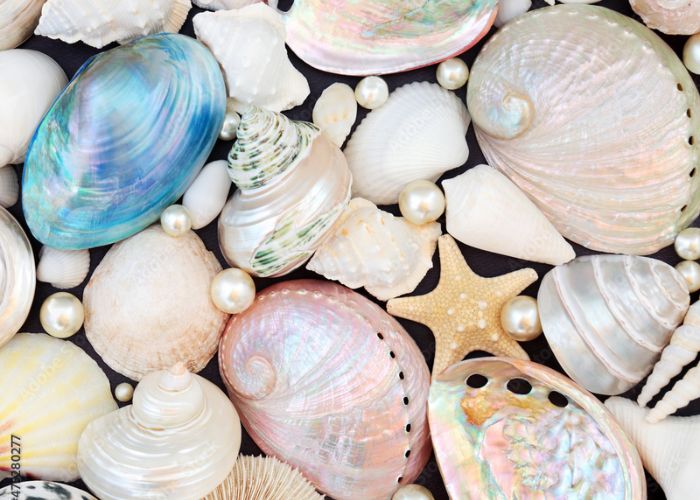
The formation of the mother of pearl is a natural defense mechanism in mollusks. When an irritant such as a grain of sand enters the mollusk’s shell, the mollusk begins secreting a combination of aragonite (a form of calcium carbonate) and conchiolin (an organic protein) to coat the irritant. Over time, these substances build up in layers, forming a smooth, lustrous nacre. This process can take years, as the layers accumulate very slowly, which is why the mother of pearl is often associated with rarity and luxury.
1.2 Types of Mother of Pearl
Mother of pearl, or nacre, comes in various types, each distinguished by the species of mollusk and the region where it is found. These variations give rise to a wide range of colors, textures, and appearances, making mother of pearl highly versatile in jewelry, art, and design. Here are some of the main types:
- White Mother of Pearl: The most common type, white mother of pearl, is harvested from the shells of oysters and freshwater mussels. It features a soft, iridescent glow with hues of silver and cream. This type is popular in fine jewelry and decorative objects due to its classic, elegant appearance.
- Black Mother of Pearl: Black mother of pearl, primarily sourced from the black-lipped pearl oyster (Pinctada margaritifera), is known for its rich, dark tones. Its colors range from deep grey to black, often with hints of green, blue, or purple, adding an exotic appeal. Black nacre is commonly used in luxury jewelry and inlays for musical instruments.
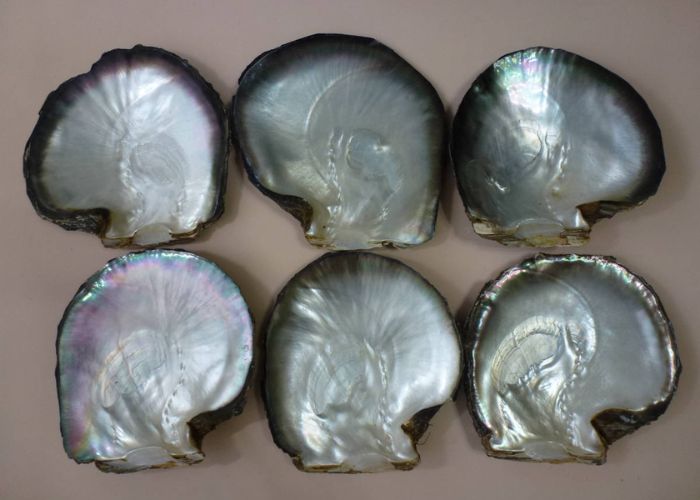
- Gold-Lipped Mother of Pearl: Sourced from the gold-lipped pearl oyster (Pinctada maxima), this type is rare and highly prized. It has a warm, golden hue with radiant overtones, making it a favorite for high-end jewelry and design projects. The natural gold color of the nacre is considered a sign of opulence and refinement.
- Pink and Blue Mother of Pearl: Some types of abalone shells produce nacre with unique pink or blue hues. These colors are vibrant and striking, often used in bohemian or artistic jewelry designs. Pink mother of pearl is particularly popular for its soft, romantic appearance, while blue nacre is cherished for its cool, oceanic tones.
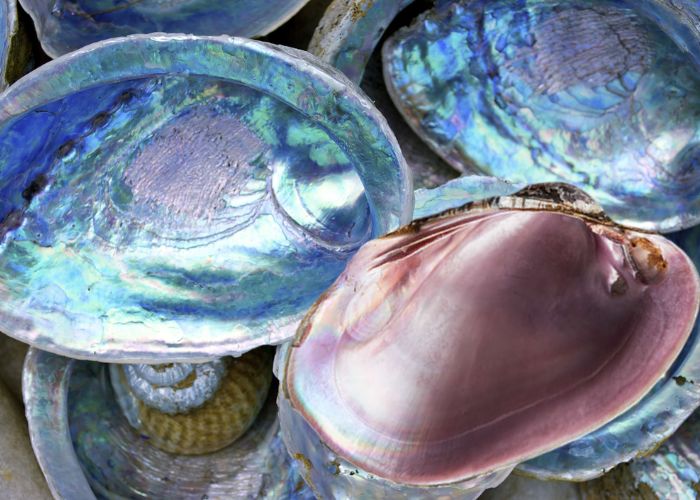
1.3 What is the Value of Mother of Pearl?
Mother of pearl holds both material and symbolic value, making it a sought-after material in various fields, from jewelry to interior design and art. Its value is shaped by factors such as its beauty, rarity, cultural significance, and versatile uses.
- Material Value: Mother of pearl’s iridescent shimmer, called “orient,” makes it a prized material for luxury items. Its ability to reflect light in a rainbow of colors creates a unique visual appeal, and its natural durability makes it ideal for inlays, jewelry, buttons, and decorative pieces. The more vibrant the color and smooth the surface, the higher its monetary value. Rarer varieties like black or gold-lipped nacre can fetch higher prices due to their scarcity and distinct hues.
- Symbolic Value: Beyond its physical attributes, mother of pearl holds deep symbolic meaning in many cultures. It is often associated with purity, protection, and calmness, representing the ocean’s soothing qualities. In some traditions, it is believed to bring tranquility and wisdom, while also symbolizing wealth and status when used in decorative objects or worn as jewelry. Its organic formation from the mollusk’s shell embodies a connection to nature, making it an object of both spiritual and aesthetic admiration.
- Cultural and Artistic Value: Mother of pearl has been used for centuries in various art forms, from intricate inlays in furniture and musical instruments to luxurious home decor. Its ability to enhance the beauty of everyday objects has elevated it as a symbol of elegance and craftsmanship. When used in architecture or interior design, mother of pearl can transform spaces with its iridescent glow, adding a touch of sophistication.
In conclusion, the value of the mother of pearl extends beyond its monetary worth, encompassing cultural, spiritual, and aesthetic significance. Its combination of natural beauty, durability, and versatility ensures it remains a cherished material across various industries.
2. History and Culture of Mother of Pearl
Mother of pearl has been cherished by many cultures throughout history for its iridescent beauty and symbolic significance. Across ancient civilizations and into modern times, this material has been used in art, jewelry, and decoration, reflecting a deep connection between humanity and nature’s treasures.
2.1 Ancient Civilizations and Mother of Pearl
In ancient times, mother of pearl was highly valued by civilizations such as the Egyptians, Mesopotamians, Chinese, and Mayans. The Egyptians used it to inlay tombs and artifacts, associating it with the moon and rebirth, symbolizing protection and eternal life. In Mesopotamia, it adorned temples and palaces, reserved for the elite due to its divine reflective quality. The Chinese, particularly during the Tang Dynasty, crafted ornate objects like mirrors and decorative boxes from mother of pearl, believing it symbolized wisdom and prosperity. Meanwhile, the Mayans and Aztecs embedded it in religious items and jewelry, viewing it as a spiritual connector to the gods through its radiant glow.
2.2 Mother of Pearl in Modern Times
In modern times, the mother of pearls continues to be a symbol of luxury and craftsmanship, widely used in various industries. In the jewelry world, it remains a popular choice for rings, necklaces, and earrings due to its unique shimmer and natural origin. High-end watchmakers, such as Rolex and Patek Philippe, also use mother of pearl for watch dials, enhancing the visual appeal of their products.
Beyond fashion, mother of pearl is prominently featured in home decor and furniture design. Its use in inlays for cabinets, tabletops, and musical instruments adds a touch of elegance and sophistication. The material is also a popular choice in Islamic art and architecture, often found in intricately designed mosques and decorative objects.
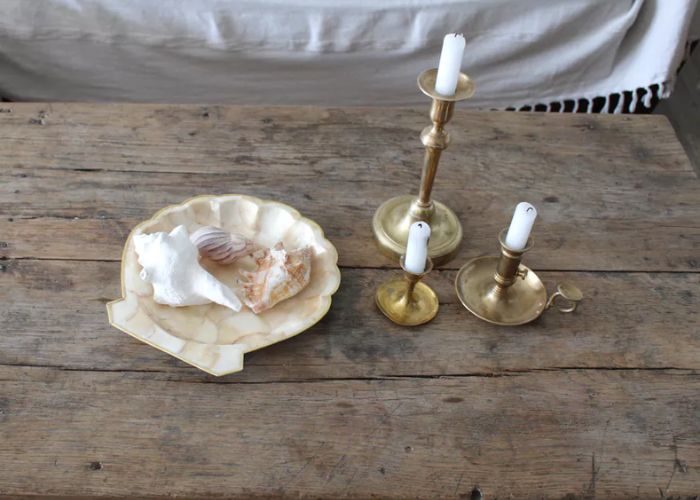
Additionally, in modern pop culture, mother of pearl has become a symbol of sustainability and connection to nature. Its organic formation and natural beauty resonate with those who seek ethical and eco-friendly alternatives to synthetic materials.
The history and culture of the mother of pearl spans millennia, from its early use in ancient civilizations to its continued prominence in modern design and fashion. Its timeless appeal, symbolic meaning, and natural beauty ensure that the mother of pearl remains a cherished material across cultures and generations.
3. Uses of Mother of Pearl
Mother of pearl, with its shimmering iridescence and durability, is a versatile material used in a wide range of industries. Its natural beauty and strength make it highly desirable for crafting fine jewelry, decorative arts, and functional items. Here are some of the main applications of mother of pearl:
3.1 Jewelry and Accessories
One of the most popular uses of mother of pearl is in the creation of jewelry and fashion accessories. Rings, necklaces, bracelets, earrings, and brooches often feature the mother of pearl for its luminous surface and elegant aesthetic. It is frequently set in silver, gold, or other precious metals to create timeless, sophisticated pieces. In fashion, mother of pearl is also used for buttons and embellishments, adding a luxurious touch to clothing, handbags, and shoes. Its lightweight and natural luster make it perfect for creating delicate, yet striking, accessories.
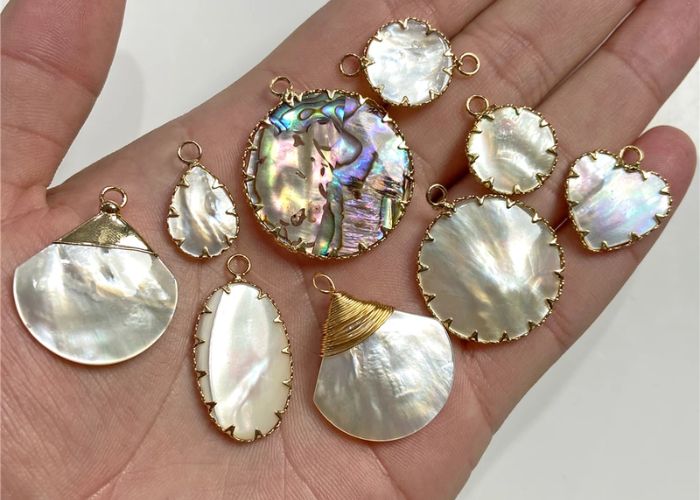
3.2 Inlay and Intarsia
Mother of pearl is a favored material for inlay and intarsia work, where it is embedded into wood, metal, or stone to create intricate designs. In furniture, mother of pearl is often used to embellish cabinets, tables, and chairs, lending a sense of luxury and craftsmanship to these pieces. Intarsia, a form of decorative inlay art, uses mother of pearl to craft stunning patterns and images on items like boxes, trays, and even architectural elements. In many cultures, especially in Islamic and Asian art, mother of pearl inlay is a traditional form of decoration, seen in religious structures, palaces, and fine furniture.
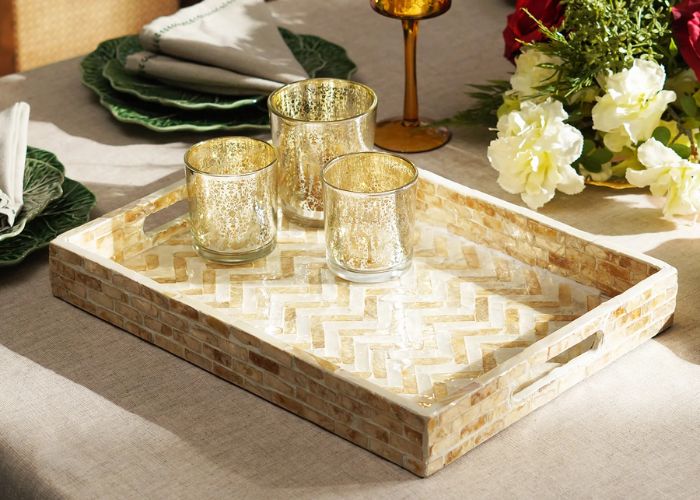
3.3 Musical Instruments
Mother of pearl has a long history of being used in musical instruments, particularly stringed instruments like guitars, violins, and lutes. It is commonly found as decorative inlay on fretboards, tuning pegs, and headstocks, adding both beauty and durability to the instrument. The material is also used in the keys of high-end pianos, accordions, and clarinets, giving these instruments a unique, polished appearance. In addition to aesthetics, mother of pearl provides a smooth surface that enhances the musician’s tactile experience while playing.
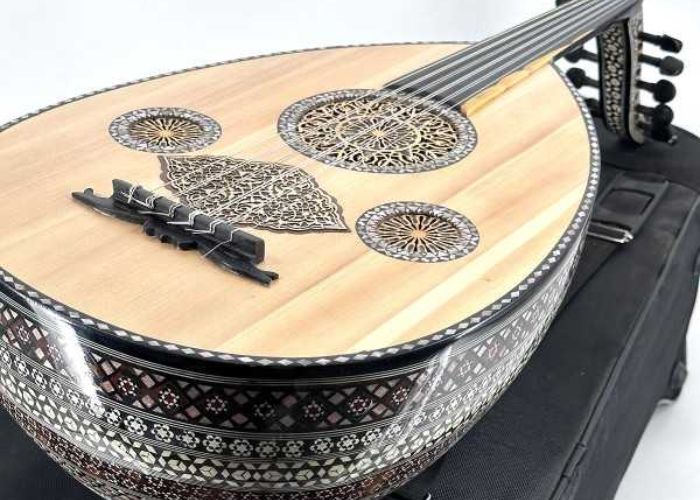
3.4 Other Applications
Beyond jewelry, inlay, and musical instruments, mother of pearl finds use in various other applications. It is a popular choice for luxury watch dials, prized for its radiant shine that changes with the light. High-end brands like Rolex often incorporate mother of pearl in their watches to elevate their design.
Mother of pearl is also used in interior design, where it decorates wall panels, mirrors, and lighting fixtures, creating a luminous effect in spaces. Its natural iridescence adds an opulent feel to modern interiors, often seen in luxury hotels and homes.
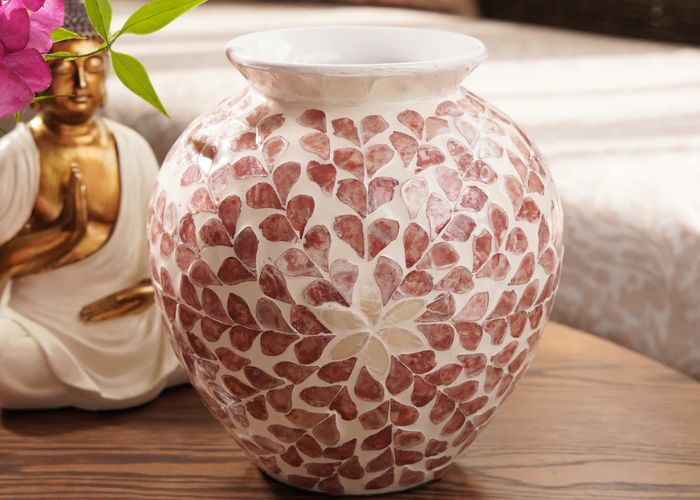
In addition, mother of pearl is utilized in the crafting of buttons for high-end garments, knife handles, and even small religious or spiritual objects. Its combination of beauty, strength, and versatility makes it a valuable material in many creative fields.
Mother of pearl’s diverse uses, ranging from fine jewelry to intricate inlays and musical instruments, highlight its versatility and timeless appeal. Whether for aesthetic, functional, or symbolic purposes, it remains a cherished material that enhances the beauty of any item it graces.
4. The Value of Mother of Pearl
Mother of pearl, or nacre, is prized for its lustrous beauty and versatility, with applications in jewelry, home decor, and luxury items. Its value, however, is determined by several factors, ranging from its appearance and rarity to its ethical sourcing. Proper care is also essential to preserve its beauty and longevity.
4.1 Factors Affecting Value
The value of mother of pearl is influenced by a number of factors:
- Color and Iridescence: The most valuable pieces of mother of pearl display a strong, vibrant iridescence with a wide spectrum of colors. The depth of the reflective hues, often called “orient,” is a key determinant of its worth. Certain colors, such as pink, blue, or gold, which are rarer in nature, tend to be more expensive than white or silver hues.
- Type and Origin: Different types of mother of pearl, such as black, gold-lipped, or abalone nacre, are valued differently based on their rarity and visual appeal. For instance, black mother of pearl, found in the black-lipped oyster, and gold-lipped nacre, sourced from Pinctada maxima oysters, are generally more expensive due to their scarcity and unique colors.
- Size and Thickness: Larger and thicker pieces of mother of pearl are more valuable because they offer more material for crafting high-quality products. Thicker nacre indicates a longer formation period, making it more durable and visually appealing.
- Condition and Craftsmanship: The quality of the mother of pearl is critical. Flawless, smooth surfaces without cracks, scratches, or blemishes command a higher price. Additionally, the craftsmanship involved in transforming raw mother of pearl into jewelry, inlays, or luxury items can significantly influence its value.
4.2 Caring for Mother of Pearl
Proper care is essential to maintain the beauty and longevity of mother of pearl:
- Avoid Harsh Chemicals: Mother of pearl is sensitive to chemicals found in household cleaners, perfumes, and cosmetics. Exposure to these substances can dull its iridescence and damage the surface. It is best to clean the mother of pearl with a soft, damp cloth and avoid using any abrasive materials.
- Keep Away from Heat and Sunlight: Prolonged exposure to direct sunlight or excessive heat can cause the mother of pearl to become brittle and fade. It should be stored in a cool, shaded place, ideally wrapped in a soft cloth to protect it from scratches.
- Gentle Handling: Since mother of pearl is relatively soft compared to other gemstones, it is prone to scratches and chips. Handle pieces with care, and store them separately from harder materials like metal or other gemstones to avoid damage.
4.3 Ethical Sourcing
The ethical sourcing of mother of pearl is becoming increasingly important as consumers seek sustainable and responsible materials:
- Ethical sourcing of the mother of pearl is becoming increasingly important as consumers seek sustainable and responsible materials. Overharvesting mollusks for mother of pearl can lead to environmental degradation and endanger certain species. To address this, many producers now follow sustainable harvesting practices that protect marine ecosystems and ensure long-term availability.
- Ethical sourcing programs balance demand with environmental responsibility by regulating how and where shells are collected. Additionally, fair labor practices are a key aspect, ensuring that workers in regions where shell harvesting is vital to livelihoods receive fair wages and work in safe conditions. Buyers can look for certifications from organizations promoting ethical and sustainable practices, ensuring transparency and helping consumers make informed, responsible choices.
5. Mother of pearl vs pearl comparison
Mother of pearls and pearls are both exquisite materials derived from mollusks, yet they differ significantly in their formation, characteristics, uses, and value. Understanding these differences can help you appreciate each material’s unique qualities and applications.
Formation:
- Mother of Pearl: Also known as nacre, mother of pearl is the iridescent inner layer of mollusk shells, primarily produced by oysters and abalones. It forms as the mollusk secretes layers of aragonite and conchiolin to protect itself from irritants. This layering process results in a lustrous surface that exhibits a beautiful play of colors.
- Pearl: In contrast, pearls form inside the body of a mollusk as a defense mechanism against irritants like sand or parasites. The mollusk secretes layers of nacre around the irritant, eventually creating a pearl. Unlike the mother of pearls, pearls are generally spherical or oval in shape and are often categorized as natural or cultured, depending on their origin.
Characteristics:
- Mother of Pearl: Mother of pearl is known for its shimmering, iridescent surface, often displaying a range of colors, including white, pink, and black. It is relatively durable, lightweight, and smooth to the touch, making it suitable for inlays and decorative applications.
- Pearl: Pearls are prized for their luster and round shape, with a smooth surface that reflects light beautifully. They can vary in size, color, and shape, depending on the type of mollusk and the conditions in which they are formed. Natural pearls are rare and often more valuable than cultured pearls, which are created through human intervention.
Uses:
- Mother of Pearl: Due to its beauty and durability, mother of pearl is widely used in jewelry, buttons, decorative inlays, musical instruments, and luxury home decor. It is also employed in artistic applications, adding elegance to furniture and decorative objects.
- Pearl: Pearls are primarily used in jewelry, where they are crafted into necklaces, earrings, bracelets, and rings. Their classic beauty makes them a timeless choice for formal and bridal jewelry. They are also sometimes used in cosmetics and skincare products due to their purported beauty benefits.
Value:
- Mother of Pearl: The value of mother of pearl depends on factors such as color, type, size, and craftsmanship. While it can be expensive, especially for rare varieties, it is generally more affordable than high-quality pearls.
- Pearl: Pearls can be significantly more valuable, especially rare natural pearls or high-quality cultured pearls from renowned sources. Their value is influenced by size, shape, color, luster, surface quality, and origin.
6. Conclusion
In summary, while both mother of pearls and pearls are beautiful materials sourced from mollusks, they differ in formation, characteristics, uses, and value. Mother of pearl, with its iridescent sheen and versatility, is ideal for decorative applications, while pearls are treasured for their unique shapes and lustrous appearance in fine jewelry. Each material has its distinct charm and cultural significance, making them both cherished in their own right.
If you have any further questions, don’t hesitate to send thanhcongcraft an email us at info@thanhcongcraft.com or message us at WhatsApp: +84967485411. Hope to serve you soon! Best regard!


